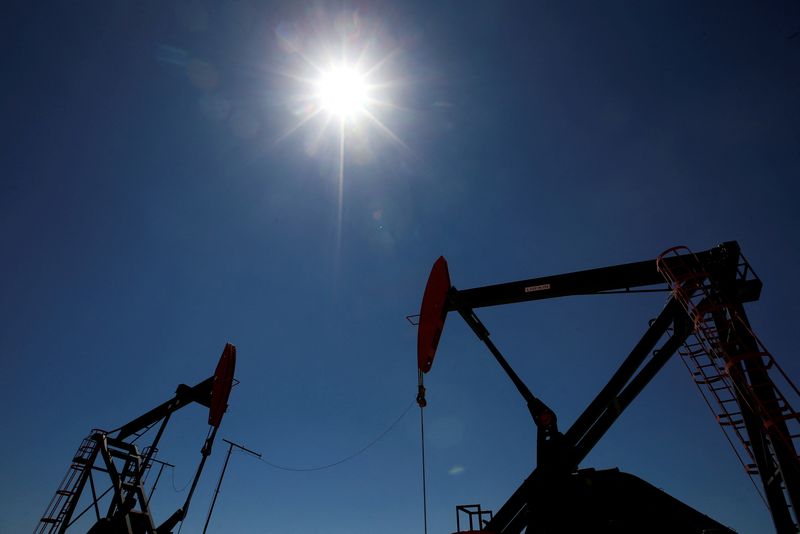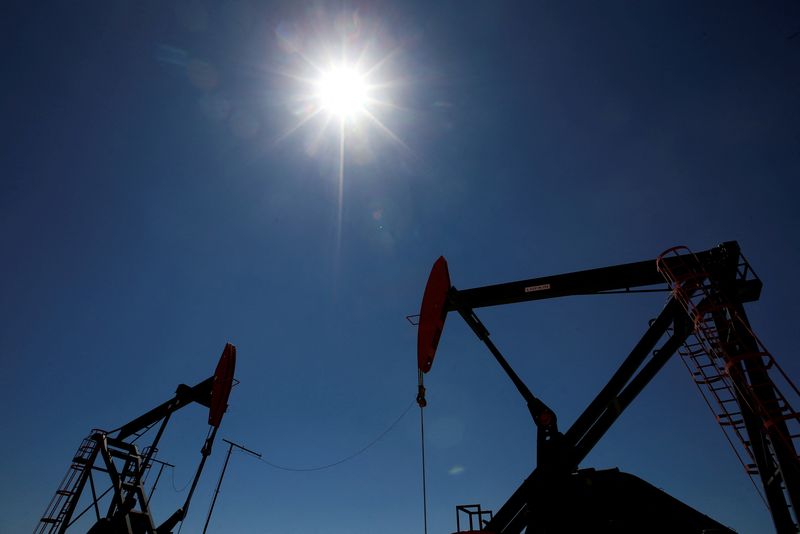Commodities
Oil prices jump as Middle East turmoil roils markets


© Reuters. FILE PHOTO: Oil rigs are seen at Vaca Muerta shale oil and gas drilling, in the Patagonian province of Neuquen, Argentina January 21, 2019. REUTERS/Agustin Marcarian/File Photo
By Natalie Grover
LONDON (Reuters) -Oil prices surged more than 3% on Monday as military clashes between Israel and the Palestinian Islamist group Hamas ignited fears of a wider conflict in the Middle East.
was up $2.70, or 3.2%, to $87.28 a barrel by 1143 GMT, while U.S. West Texas Intermediate crude was at $85.57 a barrel, up $2.78 or 3.4%.
Both benchmarks spiked by more than $4 a barrel earlier in the session.
The surge in oil prices reversed last week’s downtrend – the largest weekly decline since March – in which Brent fell about 11% and WTI retreated more than 8% as a darkening macroeconomic outlook intensified concerns about global demand.
While the underlying supply-demand balance is unaffected, said Tamas Varga of oil broker PVM, “any rise in tension in the Middle East usually leads to an increase in oil prices and it is no different this time around”.
Hamas on Saturday launched the largest military assault on Israel in decades, triggering a wave of retaliatory Israeli air strikes on Gaza.
The eruption of violence threatens to derail U.S. efforts to broker a rapprochement between Saudi Arabia and Israel, in which the kingdom would normalise ties with Israel in return for a defence deal between Washington and Riyadh.
Saudi officials reportedly on Friday told the White House that they were willing to raise output next year as part of the proposed Israel deal. Riyadh and Moscow have agreed to a combined 1.3 million barrel per day (bpd) voluntary cut until the end of 2023.
The question is how long this oil rally will last, Citi analysts said.
“Timing is everything and the attacks almost certainly postpone any Saudi-Israeli rapprochement, along with any high probability expectation of Saudi Arabia reducing or eliminating its extra 1 million bpd cut if prices resume their recent fall.”
There are also questions about whether Iran will be implicated in the conflict.
“If the conflict envelopes Iran… up to 3% of global oil supply is at risk. And if a wider conflict eventuates that ends up impacting transit through the Strait of Hormuz, around 20% of global oil supply could be held hostage,” energy analyst Saul Kavonic told Reuters.
Separately on Monday, OPEC raised its world oil demand forecasts for the medium and long term, in contrast with other forecasters, including the International Energy Agency (IEA) which has said demand could peak this decade.
Commodities
Oil prices rise; U.S. crude inventories plunge, Russia-Ukraine truce eyed
Commodities
India’s Reliance to stop buying Venezuelan oil over US tariffs, sources say
Commodities
Oil prices climb on Venezuela supply worries

 Forex3 years ago
Forex3 years agoForex Today: the dollar is gaining strength amid gloomy sentiment at the start of the Fed’s week

 Forex3 years ago
Forex3 years agoUnbiased review of Pocket Option broker

 Forex3 years ago
Forex3 years agoDollar to pound sterling exchange rate today: Pound plummeted to its lowest since 1985

 Forex3 years ago
Forex3 years agoHow is the Australian dollar doing today?

 Cryptocurrency3 years ago
Cryptocurrency3 years agoWhat happened in the crypto market – current events today

 World3 years ago
World3 years agoWhy are modern video games an art form?

 Commodities3 years ago
Commodities3 years agoCopper continues to fall in price on expectations of lower demand in China

 Economy3 years ago
Economy3 years agoCrude oil tankers double in price due to EU anti-Russian sanctions























